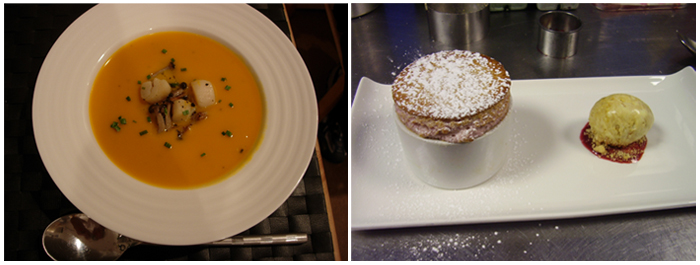|
 Chef Profile: The Tasty Journey of Chef Joe McCafferty Chef Profile: The Tasty Journey of Chef Joe McCafferty
Prior to joining Nobu, McCafferty worked at the Boxwood Café in London under the guidance of Gordon Ramsay.
When he's not preparing the finest in sushi delights, McCafferty can be found cooking Chinese cuisine at home with his Shenyang born spouse. His favourite Chinese dish is Ginseng Chicken Soup.
DS: What inspired you to become a chef?
JM: Both my grandmothers, one was a professional chef in the 1950s when this profession was still very much male-dominated, and my other gran baked a lot of cakes and desserts. They were a big influence on me - I liked watching my grandmas cooking all kinds of amazing dishes in our kitchen at home and being part of it whenever possible. The kitchen has been my favourite playground throughout my childhood and still is today.
DS: When did you cook your first proper meal?
JM: I started preparing the meals for my family around the age of 12. I liked Italian cuisine at that time, and they said it was delicious.
DS: At the age of 16, you began your culinary career training in Perigord, France where you worked at a classic family-run French restaurant. What was the experience like?
JM: It was a very encouraging start for me. I was very lucky to have a very supportive teacher who taught me his secret ‘triangular’ formula which is still a useful source of inspiration for my cooking today. I also learnt the importance of selecting good ingredients. I was taught if something tastes good raw, then it will naturally taste good cooked, unless you are a bad chef! That is of utmost importance to good cooking.
DS: What is this ‘triangular’ formula?
JM: Basically, you try to come up with a new recipe by associating the common relationship with three types of ingredients. For example, pork goes well with apple and apple goes well with scallops, so pork and scallop might go well together too. Then you can try to create a new recipe with pork and scallop.
Another example: chocolate goes well with strawberry, strawberry goes well with green tea, so you try to create a recipe with chocolate and green tea. Try it out yourself at home with ingredients that you know go together and add something new. It works really well! It’s not something like proven science but it is just a good method of inventing original recipes and trying new flavors.
DS: After training in France, you worked at a four-star hotel in Edinburgh, Scotland and then moved to London in August 2008. Your first job in London was with the Gordon Ramsay-owned Boxwood Café. How did you get into this job?
JM: I sent my CV to Gordon Ramsay’s website for an opening at that time though I was not really considering moving to London. But the restaurant contacted me a few times and said they were interested in seeing me. So I had an interview and trial with them in London. Soon after I got their offer and started my professional life in London since then.
DS: How did you find Gordon Ramsay?
JM: I found Ramsay friendly, approachable and down-to-earth. He is quite different from TV or how the media generally present him.
DS: After this experience, you moved on and are now working at the first Michelin-star Nobu London since January 2010. Is there anything special about working in a Japanese kitchen?
JM: I decided to work in a Japanese restaurant as I wanted to learn some of the unique techniques offered by Japanese cuisine and learn everything there is to know about their food.
Attention to small details is a must in a Japanese kitchen. For instance, each Japanese chef always makes sure to have a good, razor sharp knife. If you don’t have a good knife, you can hardly cook good food. That’s the philosophy of Japanese chefs.
Currently, I am mastering the skill of being able to peel a daikon so thinly that you can read the words on the newspaper through the vegetable. Indeed, there are so many things you can do better, and more, for the smallest details.
Also, I found Japanese kitchens in general have the highest standard of hygiene. At Nobu, we conduct regular cleaning competitions – from keeping the kitchen spotlessly clean to packing the fresh ingredients perfectly well within a shortest possible time.
DS: Why Japanese food then?
JM: I spent a month in Japan in 2007 and was amazed by the food culture there. I like its simplicity, and also it is a very healthy cuisine. My favourite Japanese dish is Takoyaki (fried octopus). This leisure trip ended up inspiring me to work in a Japanese kitchen someday. I am glad that this has now become real.
DS: What do you cook at Nobu?
JM: I am in charge of tempura (deep fried or battered seafood and vegetables). How to keep deep fried food light and yet healthy and fresh at the same time is a fine technique which can be trained. It’s quite different from frying fish and chips.
DS: What are your signature dishes?
JM: A few but I would say pumpkin soup with scallops and shimeji mushroom (see recipe below) and raspberry soufflé with honeycomb ice-cream.
DS: Name the best meal you have had.
JM: There were two. One was at a local restaurant in Osaka, Japan when I traveled there in 2007. I forget the restaurant name. They served really fresh sashimi set in a very beautiful, relaxing ambience.
The other one was at Foliage restaurant at Mandarin Oriental Hotel in London. They served top-quality Modern French cuisine with Asian fusion. There were no names of the dishes on the menu which merely listed out the ingredients of the dishes. I liked the nice surprises.
DS: Let’s talk a bit about your private life. You met your Chinese partner when you were in Edinburgh a few years ago, and were happily married together in China last year. What were your experiences with Chinese cuisine?
JM: I visited Beijing, Dali and Kunming in China in 2006 and traveled back to China with my wife almost every year. I found Chinese cuisine very rich, diversified and complex as China is simply such a big country. I especially like the cuisine from the North West of China which is very often about steaming.
In terms of functionality, I found the ‘function’ of Chinese cuisine is quite different from other cuisines in the sense that Chinese cuisine performs more like a social tool. People often gather to eat and enjoy a good Chinese meal over a round table together. There is not so much emphasis on fine food or dining as such. It’s not something good or bad but that is something quite unique.
Of course, I like Chinese cooking too and bought a few good Chinese cookbooks. My partner is a good Chinese cook and always seeks perfection in cooking. I enjoy learning some nice Chinese recipes from her. At home, we like cooking Ginseng Chicken Soup.
DS: Where do you get your inspiration from?
JM: Cookbooks, traveling and observing people in what they eat and how they eat. It’s important to understand the local eating culture. The same dish doesn’t necessarily work in every part of the world.
DS: Who is your food hero?
JM: Gordon Ramsay. I have read lots of his cookbooks since youth and am particularly impressed by his ability of spreading the goodness of fine food to so many people across the world at a fairly young age. It’s quite an achievement.
DS: What is the toughest part of being a chef?
JM: Long working hours. Currently, I work from 10am to midnight with a 1.5 hour break from 3:30pm to 5:00pm. And in my previous job, I worked from 8am to midnight. Also, you need to deal with pressure well. This industry is extremely fast-paced. You consistently cook and do something in a kitchen - there is no single moment to rest but just keep going.
DS: What is the most rewarding part of being a chef?
JM: The greatest experience comes when you see your guests thoroughly enjoy eating the food you cook for them, bringing with them a new enthusiasm each time. At Nobu, the kitchen is open and you cook in front of the customers. You do achieve a high level of satisfaction and motivation instantly when you see your customers are having some happy moments together over the food you cook for them. It’s a good feeling.
DS: Any words of advice to aspiring chefs?
JM: If you enjoy eating you will find the cuisine you would like to master. You can teach anyone skills, but you can’t teach passion, if you love food you will become good at it. You also need to be determined. At times, I felt like doing something else instead of becoming a chef. But the longer you stay on this profession, the more rewarding it will be and the merrier you will be.

Recipe:
Pumpkin soup with scallops and shimeji mushrooms.
1 Butternut squash (or other pumpkin)
1 large white onion
1.5l Chicken or vegetable stock
Olive oil
Sugar and salt to taste
100g butter
100g cream (optional)
1 bunch shimeji mushrooms
4 large scallops
3 tablespoons Sake or rice wine
Black pepper
1 spring onion
Peel and cut the pumpkin into 4cm chunks, finely slice the onion. Trim and wash mushrooms, keeping the stalks intact. Finely slice the spring onion. Cut the scallops in half lengthways.
Slowly fry the pumpkin and white onion with the olive oil, salt and sugar, in a big pot until it starts to break down. Then add the cold chicken stock and adjust the quantity so it covers the pumpkin. Bring to the boil, then turn down to medium heat and simmer for about 20 mins, adding more stock if needed. Then add the butter and cook a further 5 mins. Blend the soup in a food processor with the cream (if using), season with salt and pepper and keep hot, it should be quite thick.
Heat a frying pan until very hot with some olive oil and butter. Quickly stir fry the scallops, spring onion and shimeji, season with sea salt and pepper, then add the sake or rice wine right at the end and cook until nearly evaporated. Be careful not to over cook the scallops.
Serve the scallop mix on top of the soup and enjoy! |












